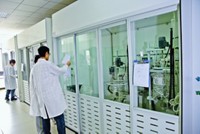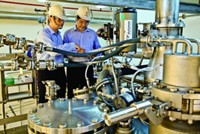Advertisement
Grab your lab coat. Let's get started
Welcome!
Welcome!
Create an account below to get 6 C&EN articles per month, receive newsletters and more - all free.
It seems this is your first time logging in online. Please enter the following information to continue.
As an ACS member you automatically get access to this site. All we need is few more details to create your reading experience.
Not you? Sign in with a different account.
Not you? Sign in with a different account.
ERROR 1
ERROR 1
ERROR 2
ERROR 2
ERROR 2
ERROR 2
ERROR 2
Password and Confirm password must match.
If you have an ACS member number, please enter it here so we can link this account to your membership. (optional)
ERROR 2
ACS values your privacy. By submitting your information, you are gaining access to C&EN and subscribing to our weekly newsletter. We use the information you provide to make your reading experience better, and we will never sell your data to third party members.
Business
India In A Rush
Crowds at CPhI India underscore the rapid evolution of the drug manufacturing industry
by Lisa M. Jarvis
December 24, 2007
| A version of this story appeared in
Volume 85, Issue 52

THE CROWDED HALLS at last month's CPhI India made it clear: Indian companies are operating with a certain sense of urgency. They are working overtime to keep up with—and cash in on—the outsized growth of their industry.
CPhI India, an outpost of the venerable European fine chemicals trade show, took place in Mumbai in conjunction with P-Mec, the Pharmaceutical Machinery & Equipment Convention, and ICSE, the International Contract Services Expo. Though only in its second year, the event is already attracting thousands of visitors. CMP, the organizer, reported that preregistration had topped 8,000 people, and attendance seemed likely to exceed the 11,000 people who streamed through the halls in the show's inaugural year. Domestic suppliers of pharmaceutical intermediates, active pharmaceutical ingredients (APIs), and related drug services made up the bulk of attendees and exhibitors. Much of the business centered on the Indian market.
The launch of CPhI India last year was both welcome and necessary, M. Venkateswarlu, the drug controller general of India, told attendees at an opening ceremony. Many small- or medium-scale pharmaceutical chemical makers do not have the resources to attend the flagship CPhI in Europe, he noted. Bringing the show to Mumbai raises companies' visibility with big pharma and gives them "the strength required to be a success in business."
Venkateswarlu emphasized that the Indian government "is committed to give all of its support to this sunrise industry." Yet one could argue that pharmaceutical chemical manufacturing in India is already beyond its sunrise. In just a few short years, Indian companies have gone "from pirates to partners," noted Smitesh Shah, managing director of Calyx Chemicals & Pharmaceuticals, speaking on behalf of the Indian Pharmaceuticals Export Promotion Council, Pharmexcil.
Shah was referring to India's traditional reputation as a hub for patent-infringing processes. But since the country's adoption of trade-related intellectual property rights, or TRIPS, in 2005, leading Indian manufacturers of intermediates and APIs have joined the same playing field as U.S. and European producers. Big pharma now trusts Indian firms to make the intermediates and APIs for even their most sensitive new products.
According to Pharmexcil, the U.S. is the industry's largest global market, soaking up 14% of India's exported drugs, pharmaceuticals, and fine chemicals. The U.S. market is also growing by leaps and bounds: Sales to the U.S. totaled $979 million in the fiscal year that ended in March, a 33% increase over the previous year.
That hectic pace was evident at CPhI, where exhibitors reported healthy foot traffic from existing and prospective customers. The quality of meetings was "tremendous," particularly considering the convention started on a Sunday, said Ankur K. Chokshi, South Asia sales director for U.S.-based Colorcon. He noted that Colorcon, which supplies drug companies with coatings, modified-release technology, and excipients, did not have a booth at last year's show but needed one this year.
For the specialty chemicals firm Johnson Matthey, the show was an opportunity to buttress its rapidly growing Indian business. The company put down roots in India roughly 15 years ago when it established the joint venture Arora Matthey. Then four years ago, Johnson Matthey opened a technical center to support its local customer base, said Shantanu Chatterjee, a market analyst with the company. It followed in 2004 with a manufacturing site in Taloja, outside Mumbai.
"Today, we have 65-75% of the market share in India for precious metal catalysts for use in fine chemicals and pharmaceuticals," Chatterjee said. Market penetration has come so quickly that the company's 2011 sales goals for India were achieved this year.
To adjust to this rapid expansion, Johnson Matthey recently added a homogeneous catalyst plant in Taloja and is now doubling capacity for heterogeneous catalysts.
Mumbai-based Glenmark Pharmaceuticals is also enjoying a healthy market for its relatively young intermediates and APIs business. Glenmark entered the bulk drug arena in 2002 when it bought GlaxoSmithKline's API facility in Ankleshwar.
Today, Glenmark also operates plants in Solapur and Kurkumbh, India. The three facilities cover the firm's own intermediates and API needs as well as its third-party business. "Our main aim is to be the primary or secondary source for major generic companies around the world," says Mahesh P. V. R. N., general manager for marketing at Glenmark.
Yet a visit to CPhI India makes clear that the country's infrastructure hasn't come close to keeping up with the business' progress. Though the airports in Mumbai are undergoing dramatic modernization, progress is negligible on the traffic that chokes the streets of any big city in the country.
And even CMP, with vast experience in conference planning, couldn't prevent the particular glitches that come with holding an event in India. When the lights flickered off in the middle of a meeting, attendees had to sit patiently in the dark. At that moment, they seemed to be waiting not just for the power to come back on but for the rest of the country to catch up with their quickly evolving industry.






Join the conversation
Contact the reporter
Submit a Letter to the Editor for publication
Engage with us on Twitter